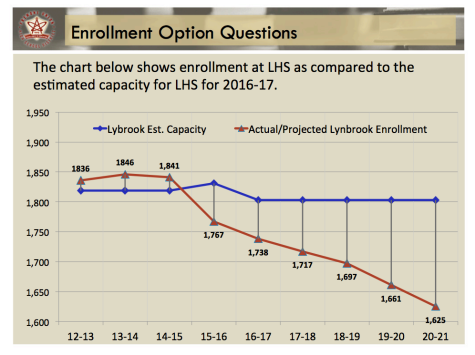The Bar-On Brief: Cupertino and Lynbrook’s problems may soon be ours as well
Board’s vote a good first step, but the next step matters more

School attendance boundaries? Imagine they didn’t exist. Imagine you had the option of enrolling in any FUHSD school.
This is not going to happen next year, but it very well could happen in the future due to the precedents made in last week’s district board vote regarding Lynbrook and Cupertino High.
First, some background. Everybody knows that our district is growing. Enrollment projections consultants have projected huge growths for all schools in the next few years. That’s why our school enacted measure B, to build more classrooms and facilities.
But Lynbrook’s enrollment is not expected to grow. In fact, Lynbrook’s enrollment is projected to decrease. Cupertino, on the other hand, is expected to be the largest school in the district in a few years.
What’s the problem with declining enrollment? Well first of all, if a school loses students, it cannot offer certain classes. It will need to make budget cuts that will ultimately impede academic quality.
In addition, it just doesn’t make sense for one school to have 2,400 students while the neighboring school, very accessible to the community of the larger school, has a mere 1,600.

Now, the easiest way to increase a student population is by changing the attendance borders — increasing Lynbrook’s and decreasing Cupertino’s. The community has clearly expressed that it will not agree to such a quick, drastic change at the moment, and the board did not even consider voting on such an option in a Jan. 9 meeting.

Instead, the “open-enrollment” concept was presented. Originally, the debate focused around the John Mise Plan. This plan would permit a select number of students in the John Mise Park area that would otherwise attend Cupertino to have the option of enrolling at either Cupertino or Lynbrook.
Again, it was met with too much resistance, and the issue did not have enough support to be voted on.
The plan that was approved last week was the Miller Plan. Same idea as the John Mise plan — students attending Joaquin Miller Middle School would have the option to enroll in either Cupertino or Lynbrook.
The Miller Plan does not violate the FUHSD Board Policy. Policy #5116 explains that open enrollment policies can be adopted “when a district school is under capacity.”
In regards to the Miller Plan, we’re talking a max of about 75 kids that would transfer from Cupertino to Lynbrook– not enough to fix the problem. Nonetheless, it’s a good idea.
But it all depends on the next step. The Miller Plan can be a prerequisite to one of two things:
Either the school attendance borders will be altered to increase Lynbrook’s enrollment — the better opinion — or, as the board “slightly considered,” it will allow any student in the district to open enroll into Lynbrook
If such a policy is adopted for Lynbrook, it will set a dangerous precedent, sparking debates to make the entire district one big open enrollment party — something that would be a mess for everyone — housing prices, traffic problems, lack of student diversity and the further divisions in high school “specialties.”
Certain groups of students, those of similar ethnicities, religious backgrounds and social classes, would cluster together in different schools. Do we really want such divisions?
One school would be the better athletics school, for example, while another school would perhaps excel in mathematics. High school “admissions” would become similar to college majors.
When I talked to Principal Greg Giglio, the two of us agreed that HHS is not directly affected by other schools’ enrollment problems. But we both agreed when I said, “not yet.”
And with that, I rest my case.











A Non-Participant • Jan 20, 2016 at 10:46 pm
“Certain groups of students, those of similar ethnicities, religious backgrounds and social classes, would cluster together in different schools. Do we really want such divisions?”
Though an opinion article, logical leaps are not to be excused. What the writer meant to say was “groups of students, those whose families are of similar socio-economic background, earning a relatively similar amount of money, would cluster together in different schools.” And, as commenter Michelle pointed out, this is already happening. It just happens to be that those who are earning a certain amount are Asian, and those earning another amount are Latino. There’s a process from A to B, but the distinction is undeniable.
However, when in the world did religious backgrounds play a role in this? We’re talking about education, money, and status. The article had been using facts to support its arguments up to the point about religious divisions. Religion and the distribution of wealth have little to no correlation, and the author clearly just wanted something to spark controversy and interest in the reader’s mind.
I sense an underlying tone of stereotyping in the author’s mind, and, though again keeping in mind that this is an opinionated article, a check in political correctness and word choice would be in order. Why does he imply that one school might be more athletic than the other? How does any of the previous data that has been revealed support that point? Why would some excel in mathematics? While data does show correlation between certain groups and certain areas of skill, leaping to the conclusion without the data or the proper phrasing and establishment of the situation demonstrates a lack of proper etiquette and lack of attention on the writer’s part.
Also, this isn’t a court case, you have no case to rest, just an opinion to throw at the masses.
Michelle • Jan 20, 2016 at 7:24 pm
Although the argument that other problems might increase with open enrollment is valid, “clusters” of students based on ethnicity/race/economic status is already a reality and should not be considered an issue that is only a result of open enrollment.
For instance, Homestead is 45.27% Asian, while Fremont is 43.32% Latino. Homestead’s ethnic makeup doesn’t even list Latino people, instead filing them under “Other” on the school profile. This is fairly blatant de facto segregation, and the already strange divisions in the district map call into question whether these divisions were intentionally racially biased.
Perhaps under open enrollment, the people who live in the Homestead attendance area in Sunnyvale but closer Fremont (a vast majority of people who live in North Sunnyvale) would attend Fremont instead of Homestead which would actually even out the racial makeup of the schools.
Anonymous • Jan 20, 2016 at 10:52 pm
Nah I’m good homie